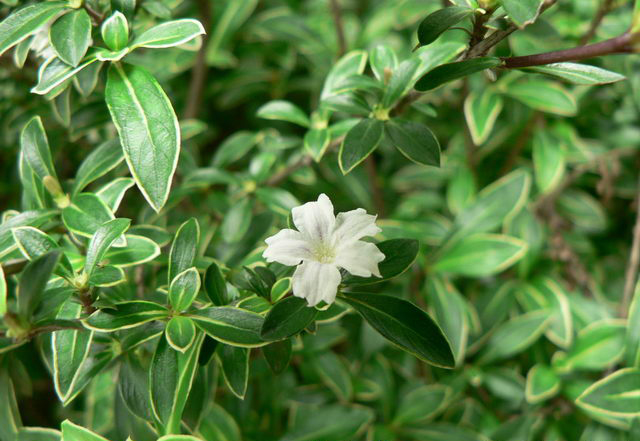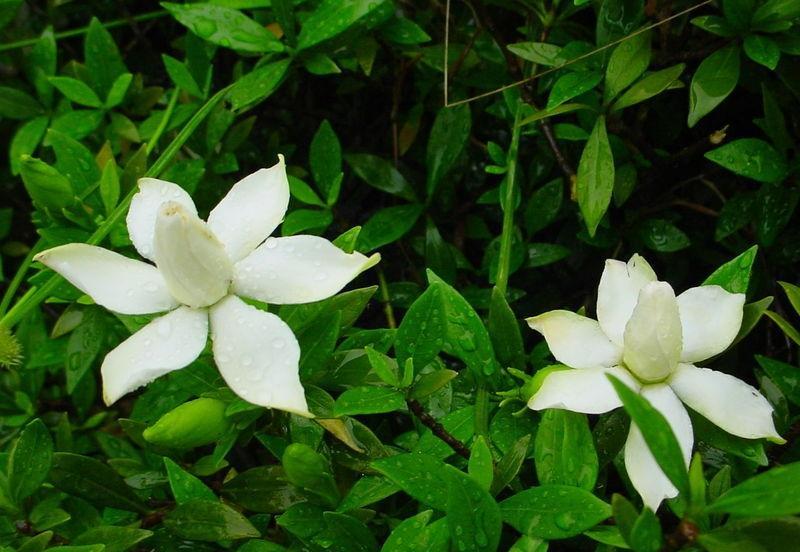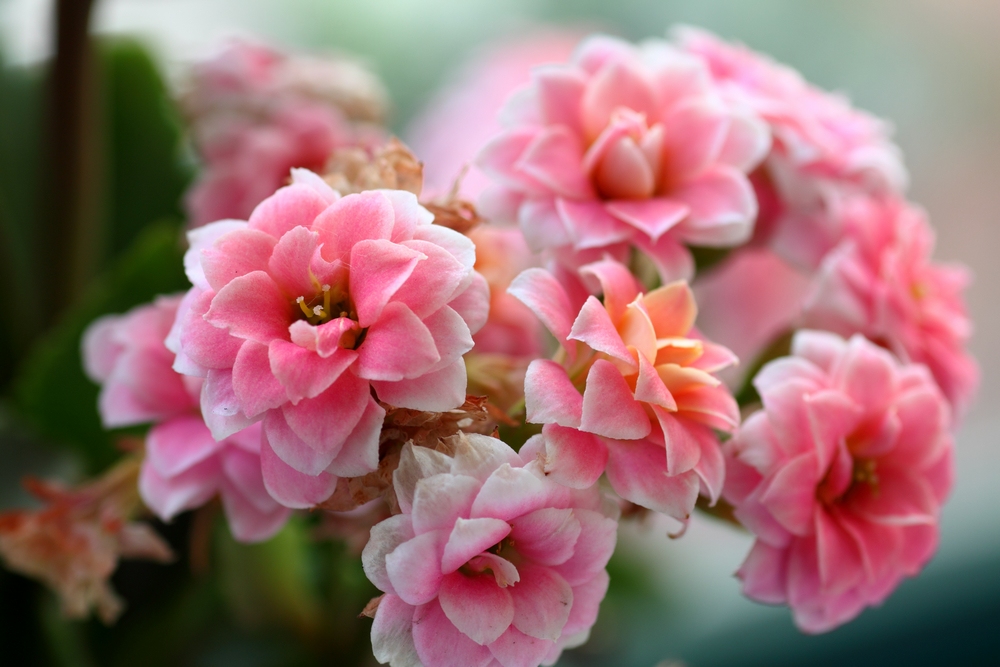Culture methods and matters needing attention of snow in June
June snow, the name, sounds very sad. Ha ha. Is it possible that the painting is white, with fine white flowers in June, the smallest tree and sparse branches and leaves? Like light shade, afraid of the sun, there are many under the leaves and trees in the mountains. Spring planting, or Huangmei rain cutting, it is appropriate to pour shallow tea. The temperature is not strict, it is evergreen in South China and semi-evergreen in Southwest China. The drought tolerance is strong, and the soil is not strict. Pot culture should use humus, loose and fertile, strong permeability of slightly acidic, moist culture soil, good growth. Roots, stems and leaves can be used as medicine. Light, slightly pungent, cool. Soothing the liver and relieving depression, clearing heat and dampness, detumescence and detoxification, relieving cough and resolving phlegm. For acute hepatitis, rheumatism, waist and leg pain, abscess, snakebite, spleen deficiency and diarrhea, infantile disease, eye nebula, intestinal carbuncle, rabies. June snow (Latin name: Serissa japonica (Thunb.) Thunb.), Rubiaceae evergreen shrub, up to 90 cm tall, smelly. Leaves leathery, stalk short. Flowers solitary or several clustered on top of branchlets or axillary, Corolla reddish or white, style long and prominent, flowering from April to July. Next, the editor of the net will introduce the snow in June.

Culture methods and matters needing attention of snow in June
June snow culture methods and matters needing attention 1: transplant into the pot
Generally speaking, February to March is the best time for transplanting, of course, Meiyu and late autumn are also good seasons. When transplanting, the pot chosen is purple sand basin and glaze basin, and the basin color should be dark, which can form a sharp contrast with the flower color. The basin soil is required to be sandy, which should be loose and rich in organic matter and good drainage. In addition, in the choice of fertilizer, pine needle soil, humus soil and peat can be mixed with each other, and about 10% rice husk ash should be added.
Culture methods and points for attention of snow in June 2: water and fertilizer management
The water and fertilizer management of snow in June should be suitable, not too dry or too wet, keep an appropriate amount of water in basin soil, reduce watering times in winter, and generally spray water on leaves for 1-2 times in summer. In addition, April to May is the best time to apply fertilizer, which can be irrigated with 0.5% phosphate and potassium fertilizer, and can be re-fertilized in winter to irrigate thin organic fertilizer. Heavy fertilizer is a big taboo.
June snow culture methods and matters needing attention 3: light and temperature requirements
June snow likes sunshine, warmth, moisture and ventilation. Therefore, maintenance should be carried out in these conditions during the growing season. Summer should be properly shaded, must not be exposed to the sun, winter should be moved indoors, to maintain a certain temperature, such as 5 to 12 degrees Celsius.
Breeding methods and points for attention of June snow 4: turning basin and pruning
Turning the basin every other year can make the soil more loose and suitable for plant growth. At the same time, the removal of the old soil and proper pruning of the roots can also improve its ornamental value. In winter, plastic pruning should be carried out, long and short branches should be trimmed, and sparse and dense branches should be trimmed, which can not only remove messy branches and leaves, improve the aesthetic sense of ornamental, but also cut off the branches and leaves of diseases and insect pests. At the same time, through heart-picking, sprouting, removing branches, etc., to maintain a certain shape, elegant and moving.
Breeding methods and matters needing attention of snow in June 5: pest control
Snow in June generally has fewer diseases and insect pests, and occasionally there are aphids. At this time, you can use wind oil essence spray, you can kill aphids, but the concentration should not be too high, dilution 500 to 600 times is more appropriate. In addition, root rot sometimes occurs. At this time, it is irrigated with 800x solution of Gen Fuling or 600x-1000 times of 12% oleic acid copper EC and sprayed every other time for three times in a row.
Culture methods and matters needing attention of snow in June
The culture method of June snow
Light
June snow is afraid of strong light, so daily maintenance needs to be shaded and placed in a cool place to avoid direct sunlight and absorb scattered light.
Watering
Keep the basin soil moist throughout the year.
Hot and dry in summer, in addition to watering every day, you also need to spray the foliage with clear water, or spray the nearby ground to maintain the relative humidity of the air.
When the temperature drops in autumn, the amount of water should be controlled gradually and watered once every 2 to 3 days.
Water can be watered every 7 to 10 days in winter.
Fertilizer application
In the growing season, thin liquid fertilizer is applied every 15 days, or water belt fertilizer is also available, that is, thin liquid fertilizer is added every time it is watered.
Temperature
June snow likes a warm climate, slightly cold-resistant, winter temperature is relatively low, need to be transferred to indoor cultivation, indoor temperature can not be lower than 0 ℃, June snow is very easy to die if frozen.
Soil
June snow does not have strict requirements on the soil, and grows best in soils with good porosity, permeability and venting.
Matters needing attention in Snow Culture in June
Often topdressing
In addition to normal fertilization, external topdressing should be carried out frequently. In the growing season, topdressing can be applied 3 to 4 times, and 1% potassium dihydrogen phosphate solution is used to spray leaves to adjust pH and increase plant nutrition.
Avoid sun exposure in summer
In summer, plants should be placed in a cool place, and a half-light shade can be built with small-hole nylon mesh or plastic window screen, which can not only maintain ventilation, but also absorb scattered light.
Pay attention to ventilation in summer
Placed in indoor maintenance in summer, it is necessary to increase ventilation, otherwise the branches will grow only, the leaves will turn yellow, and the lower leaves will fall off a lot.
The basin needs to be changed in spring
Every year in March and June, the snow can be transferred outdoors, before the need to use rotten leaf soil to change the basin, and at the bottom of the basin with hoof corner piece as base fertilizer.
June snow bonsai how to raise, June snow breeding methods and precautions / water can not be much
June snow, many flower lovers should be no stranger, it is the most popular bonsai tree, very popular at home and abroad. In life, many novices will buy June snow bonsai from the flower market, but they don't know how to keep it. In this regard, the editor carefully sorted out the breeding methods and matters needing attention of June snow, which is very comprehensive. Friends who want to raise must have a look.
How to raise snow bonsai in January and June, you can't water too much.
After buying snow bonsai in June at the flower market, we can keep it indoors or indoors. As for how to raise snow bonsai in June, in terms of light, the requirements of June snow are not high, but we must pay attention to water and fertilizer, not much, otherwise affect the growth. The details are all in the breeding methods and matters needing attention of June snow, let's move on.
Second, the culture methods and matters needing attention of June snow
1. Soil, slightly acidic
After the snow bonsai was bought back in June, there was soil inside. The soil we are talking about here is what we need when we change the basin. June snow has strong drought tolerance, so it is not strict with the soil, but if you want it to grow well, it is best to prepare slightly acidic culture soil containing humus, loose and fertile, and strong permeability.
2. Get enough light.
In the breeding method of snow in June, light is naturally indispensable, but the specific requirements depend on the situation. If you keep it outdoors, you must give enough light to the June snow; if you breed it indoors, you can put it near the window and use fluorescent lights to make up the light when the light is insufficient.
Note: once the light is insufficient, the snow in June will be very loose, and the appearance will not be so beautiful. In addition, if you breed it outdoors and want to move it indoors, you should slowly change the environment, don't get it indoors at once, and make sure that the position you put indoors can receive light.
3. Watering, rewatering when dry
How to raise snow bonsai in June, watering is very important. It is understood that June snow likes to be wet, but hates stagnant water, so we can not water too much or too often, just keep the basin soil moist, and we should see dry rewatering.
Note: when breeding outdoors, there should be no stagnant water in the basin in the rainy season to avoid rotting roots. When the summer weather is hot, in addition to watering, it is also necessary to spray water to the leaves sooner or later to cool down and increase air humidity to facilitate its growth.
4. Fertilize once a month
After watering, let's talk about fertilization. In June snow farming method, it has a demand for fertilizer, in winter, we have to reduce fertilization, from the early summer to increase the amount, fertilization once a month.
Note: when applying fertilizer, compost is moist to avoid root tip burns. Fertilization likes slightly acidic soil conditions. Stop fertilizing when June snow has lost its leaves, or if it doesn't show new growth points.
5. Temperature, 18-26 ℃
How to raise snow bonsai in June, the right temperature is very important. It is understood that June snow likes a warm, humid environment and is not resistant to cold, and the most suitable temperature is 18-26 ℃. If the room temperature is more than 15 ℃, the evergreen leaves will not fall.
Note: although June snow is adaptable, it also needs to be protected. If it is outside, it must be moved indoors when the temperature is below 7 ℃.
Matters needing attention in breeding snow in June
In the above method of breeding snow in June, several points that need to be paid attention to have been mentioned, which I believe you should remember. However, in addition to the above mentioned, there are three points that flower friends need to pay attention to, that is, pruning, turning pots and pest control. Matters needing attention in the breeding of snow in June are as follows:
1. Pruning
Snow grows fast in June, so florists need regular pruning to keep its shape. Before the leaves fall in winter every year and sprout in the spring of next year, we should trim the snow in June, cutting short long branches, overgrown branches, thinning too dense thin and weak branches, and cutting off the branches of diseases and insect pests. In the growing period, but also to pick the heart, wipe buds, remove branches, and so on, the specific operation in June snow how to trim in detail, here will not say much.
2. Turn the basin
In order to ensure that the snow in June can have sufficient nutrients, the basin needs to be turned every 1-2 years, usually in February-March in spring. Get rid of all the old soil and replace it with clean cultivated soil: loose, fertile, permeable, slightly acidic soil. When turning the basin, the roots can be trimmed properly to form suspended roots and improve the ornamental value.
3. Pest control
The diseases and insect pests of snow bonsai in June are less, but in the process of breeding, aphids, snails, root rot and other diseases will also appear, thus affecting plant growth and eventually leading to a decline in ornamental. What to do? there is a detailed introduction to the prevention and control of diseases and insect pests in the snow in June, so I won't say much here.
- Prev

The seeds and seeds of Gardenia sinensis L.
Gardenia has a special fragrance, very good smell. Gardenia is estimated to be smaller than gardenia, suitable for raising indoors. Gardenia is an evergreen shrub. Leaves simple, opposite or 3-whorled, leaf blade obovate, leathery, emerald glossy. White, very fragrant. Berry ovate, yellow or orange
- Next

Are longevity flowers poisonous? culture methods and matters needing attention of longevity flowers
Longevity flower, I think it is a good choice to give it a gift. Because a lot of people may like the name. Longevity flower (KalanchoeblossfeldianacvtomThumb) alias Shouxing flower, fake Sichuan lotus, Christmas cabbage, dwarf cabbage
Related
- Fuxing push coffee new agricultural production and marketing class: lack of small-scale processing plants
- Jujube rice field leisure farm deep ploughing Yilan for five years to create a space for organic food and play
- Nongyu Farm-A trial of organic papaya for brave women with advanced technology
- Four points for attention in the prevention and control of diseases and insect pests of edible fungi
- How to add nutrient solution to Edible Fungi
- Is there any good way to control edible fungus mites?
- Open Inoculation Technology of Edible Fungi
- Is there any clever way to use fertilizer for edible fungus in winter?
- What agents are used to kill the pathogens of edible fungi in the mushroom shed?
- Rapid drying of Edible Fungi

